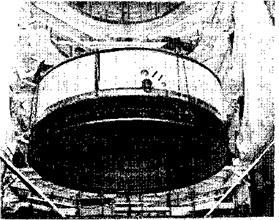AFT LOX BULKHEAD
The aft LOX bulkhead, like the aft facing sheet of the common bulkhead, is composed of 12 thin aluminum gores welded to mechanically milled waffle panels. The waffle panels are sheets into which diagonal ribs are machined to form a series of diamonds. The waffle panels are used around the middle (widest part of the LOX tank) to provide structural strength. Baffles adjacent to the aft facing sheet of the common bulkhead prevent wave action (sloshing) during flight. At the lower apex of the LOX tank, antivortex baffles, consisting of a 14-foot cruciform (four fins arranged in a cross) and 12 smaller baffles, are installed over the sump and engine supply line connections. The smaller baffles are essentially thin metal plates extending from the center of the cruciform, three between each pair of fins.
COMMON BULKHEAD
The common bulkhead may be likened to two giant domes, one placed inside the other, open end down, with a layer of insulation sandwiched between. The top dome is called the forward facing sheet and the
|
S-8 |
Bulkhead-Common bulkhead shows aft facing sheet (in sling preparatory to mating).
bottom, the aft facing sheet. The forward facing sheet has a J-shaped periphery, which is welded to the No. 1 liquid hydrogen tank cylinder. In final assembly, a 15-inch, 12-section bolting ring is bolted to the aft skirt and the No. 1 liquid hydrogen tank
cylinder. A total of 636 bolts attach the bolting ring to the liquid oxygen tank.
|
S-13 |
Gore Section of Aft Facing Sheet of Common Bulkhead Before Assembly
Insulating and joining the forward and aft facing sheets into a common bulkhead is a process of several operations. First the aft facing sheet is placed on a bonding fixture and numerous sections of honeycomb phenolic insulation are fitted and tapered to exact but varying thicknesses. Then the insulation is cemented to the aft facing sheet in a multistage bonding operation which includes chemical processing of the aft facing sheet, application of adhesive, and pressurizing and curing in the autoclave. After mating the forward facing sheet over the insulated aft facing sheet, impression checks are made to assure a perfect fit. The forward facing sheet is then chemically processed, the insulation placed on the exposed top of the aft facing sheet is prepared with adhesive, and the entire bulkhead assembly is joined and placed in the autoclave for pressurizing and curing. In both bonding operations, checks are performed with ultrasonic equipment to ensure that the adhesive has completely covered the surface.












